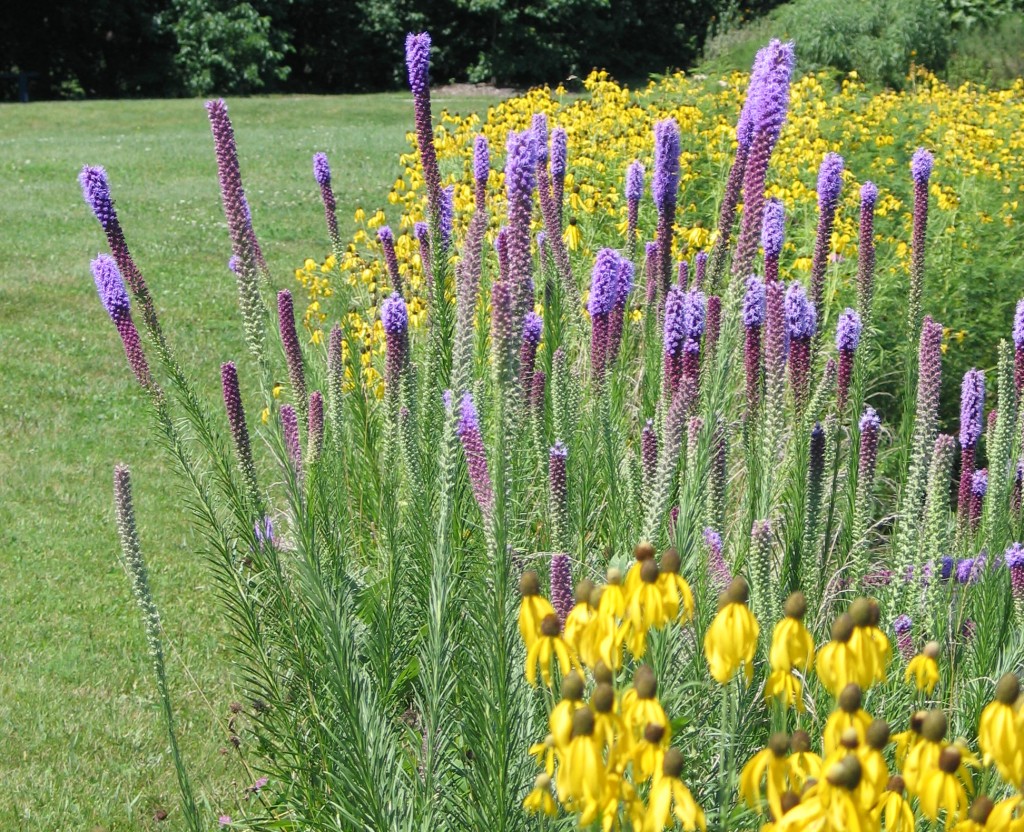With the recent rainfall, I have been reminded that native plants are a wonderful and underused means to create a natural setting around a water feature or low area in your landscape. Most prairie wildflowers and grasses don’t do well in soggy soil and excessive moisture results in rot and other deadly diseases. However, there are a handful of plants that grow in wet areas within a prairie or along pond margins. These wetland wildflowers appreciate wet feet and some even thrive in standing water. Rather than radically altering the drainage of a soggy, poorly drained site within your garden, try some of these plants that grow well in such conditions.
Swamp milkweed (Asclepias incarnata)
As the name implies, swamp milkweed prefers wet locations in full sun to partial shade. Here at the Arboretum we have it growing next to the pond and stream. In the wild, it is found in prairie seeps and potholes, at the edges of marshes, and in wet ditches. Swamp milkweed grows 3 to 4 feet tall and blooms from July, August and early September. The vanilla-scented flowers are typically pale pink to rose-purple and are a favorite for migrating monarchs.

Joe Pye weed (Eutrochium maculatum)
This tall, native perennial is found in moist meadows and marshes. The attractive leaves and purple spotted stems fill out this 6 foot tall wildflower. The rosy-pink bloorms in mid to late summer are a favorite of many pollinators. Joe Pye weed performs best in moist to wet soils in full sun. Smaller forms like ‘Baby Joe’ and ‘Little Joe’ are nice alternatives if you don’t have much space.

Blazing Star- (Liatris sp.)
You don’t typically think of blazing star as a wetland wildflower, since most species prefer dry sites. However, there are several species of Liatris that can handle wetter conditions. Kansas gayfeather (Liatris pycnostachya) and dense blazing star (Liatris spicata) are typically found in moist prairies and meadows. These blazing stars grow 3 to 4 feet tall with narrow, lance-like leaves and blooms in mid- to late summer. The pinkish purple flowers grow on 12- to 18-inch-long, upright spikes. Flowering begins at the top of the spike and moves down the stem.

Other wetland wildflowers
- Acorus calamus – Sweet Flag
- Actinomeris alternifolia – Wingstem
- Aster novae-angliae – New England Aster
- Eupatorium perfoliatum – Common Boneset
- Filipendula species – Meadow Sweet
- Galium odoratum – Sweet Woodruff
- Helenium autumnale-Helen’s Flower
- Helianthus angustifolius – Swamp Sunflower
- Hibiscus species – Rose Mallow
- Iris virginica – Southern Blue Flag
- Lobelia cardinalis – Cardinal Flower
- Lobelia siphilitica – Blue Cardinal Flower
- Mertensia virginica – Virginia Bluebell
- Monarda species – Bee Balm
- Physostegia virginiana – Obedient Plant
- Pycnanthemum tenuifolium – Narrow Leaved Mountain Mint
- Ratibida pinnata – Gray headed Coneflower
- Senna hebecarpa – Wild Senna
- Thalictrum dasycarpum – Purple Meadow Rue
- Tradescantia sp. – Spiderwort
- Verbena hastata – Blue Vervain
- Veronicastrum virginicum – Culvers Root
- Vernonia noveboracensis – Ironweed
Native grasses are quite adaptable, but several grasses and sedges can grow well in moist to wet soils. Big bluestem (Andropogon gerardii), switch grass (Panicum virgatum), prairie cordgrass (Spartina pectinata) can be found in roadside ditches, prairie bogs, and along pond edges. There are many native sedges such as gray’s sedge (Carex grayi) that perform well in moist soils in partial to full sun as well.
If there’s a drainage problem in your yard, you may be inclined to install a dry creek bed or a French drain. But don’t be too quick to go to all that work. An alternative route is to simply use plants that prefer to live in wet areas. Match plants that are native and naturalize in wet conditions. Wetland wildflowers have adaptations to grow in wet soil, so they are effective landscaping solutions for areas with drainage issues.
